Earth
Sidereal rotation period | |||||||||||||
Equatorial rotation velocity | 0.4651 km/s[17] (1674.4 km/h; 1040.4 mph) | ||||||||||||
|---|---|---|---|---|---|---|---|---|---|---|---|---|---|
| 23.4392811°[2] | |||||||||||||
| Albedo | |||||||||||||
| Temperature | 255 K (−18 °C; −1 °F) (blackbody temperature)[18] | ||||||||||||
| |||||||||||||
| Surface equivalent dose rate | 0.274 μSv/h[22] | ||||||||||||
| −3.99 | |||||||||||||
| Atmosphere | |||||||||||||
Surface pressure | 101.325 kPa (at sea level) | ||||||||||||
| Composition by volume |
| ||||||||||||
Earth is the third
Earth has
Earth is
Earth, like most other bodies in the Solar System,
Etymology
The
Historically, "Earth" has been written in lowercase. Beginning with the use of
The name Terra
There are a number of adjectives for the planet Earth. The word "earthly" is derived from "Earth". From the Latin Terra comes terran /ˈtɛrən/,[30] terrestrial /təˈrɛstriəl/,[31] and (via French) terrene /təˈriːn/,[32] and from the Latin Tellus comes tellurian /tɛˈlʊəriən/[33] and telluric.[34]
Natural history
Formation
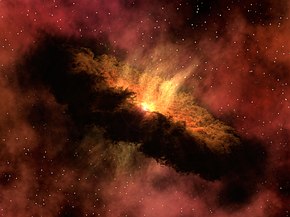
The oldest material found in the
Estimates of the age of the Moon range from 4.5 Ga to significantly younger.
After formation
Earth's atmosphere and oceans were formed by volcanic activity and outgassing.[43] Water vapor from these sources condensed into the oceans, augmented by water and ice from asteroids, protoplanets, and comets.[44] Sufficient water to fill the oceans may have been on Earth since it formed.[45] In this model, atmospheric greenhouse gases kept the oceans from freezing when the newly forming Sun had only 70% of its current luminosity.[46] By 3.5 Ga, Earth's magnetic field was established, which helped prevent the atmosphere from being stripped away by the solar wind.[47]
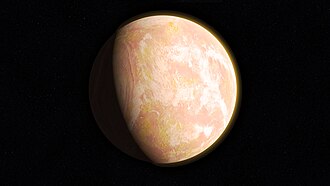
As the molten outer layer of Earth cooled it
New continental crust forms as a result of plate tectonics, a process ultimately driven by the continuous loss of heat from Earth's interior. Over the period of hundreds of millions of years, tectonic forces have caused areas of continental crust to group together to form supercontinents that have subsequently broken apart. At approximately 750 Ma, one of the earliest known supercontinents, Rodinia, began to break apart. The continents later recombined to form Pannotia at 600–540 Ma, then finally Pangaea, which also began to break apart at 180 Ma.[56]
The most recent pattern of
Origin of life and evolution
Future

Earth's expected long-term future is tied to that of the Sun. Over the next 1.1 billion years, solar luminosity will increase by 10%, and over the next 3.5 billion years by 40%.
The Sun will evolve to become a red giant in about 5 billion years. Models predict that the Sun will expand to roughly 1 AU (150 million km; 93 million mi), about 250 times its present radius.[78][84] Earth's fate is less clear. As a red giant, the Sun will lose roughly 30% of its mass, so, without tidal effects, Earth will move to an orbit 1.7 AU (250 million km; 160 million mi) from the Sun when the star reaches its maximum radius, otherwise, with tidal effects, it may enter the Sun's atmosphere and be vaporized.[78]
Physical characteristics
Size and shape
Earth has a rounded shape, through hydrostatic equilibrium,[85] with an average diameter of 12,742 kilometers (7,918 mi), making it the fifth largest planetary sized and largest terrestrial object of the Solar System.[86]
Due to Earth's rotation it has the shape of an ellipsoid, bulging at its Equator; its diameter is 43 kilometers (27 mi) longer there than at its poles.[87][88] Earth's shape furthermore has local topographic variations. Though the largest local variations, like the Mariana Trench (10,925 meters or 35,843 feet below local sea level),[89] only shortens Earth's average radius by 0.17% and Mount Everest (8,848 meters or 29,029 feet above local sea level) lengthens it by only 0.14%.[n 6][91] Since Earth's surface is farthest out from Earth's center of mass at its equatorial bulge, the summit of the volcano Chimborazo in Ecuador (6,384.4 km or 3,967.1 mi) is its farthest point out.[92][93] Parallel to the rigid land topography the Ocean exhibits a more dynamic topography.[94]
To measure the local variation of Earth's topography, geodesy employs an idealized Earth producing a shape called a geoid. Such a geoid shape is gained if the ocean is idealized, covering Earth completely and without any perturbations such as tides and winds. The result is a smooth but gravitational irregular geoid surface, providing a mean sea level (MSL) as a reference level for topographic measurements.[95]
Surface


Earth's surface is the boundary between the atmosphere, and the solid Earth and oceans. Defined in this way, it has an area of about 510 million km2 (197 million sq mi).[12] Earth can be divided into two hemispheres: by latitude into the polar Northern and Southern hemispheres; or by longitude into the continental Eastern and Western hemispheres.[citation needed]
Most of Earth's surface is ocean water: 70.8% or 361 million km2 (139 million sq mi).
At Earth's
Earth's land covers 29.2%, or 149 million km2 (58 million sq mi) of Earth's surface. The land surface includes many islands around the globe, but most of the land surface is taken by the four continental landmasses, which are (in descending order): Africa-Eurasia, America (landmass), Antarctica, and Australia (landmass).[104][105][106] These landmasses are further broken down and grouped into the continents. The terrain of the land surface varies greatly and consists of mountains, deserts, plains, plateaus, and other landforms. The elevation of the land surface varies from a low point of −418 m (−1,371 ft) at the Dead Sea, to a maximum altitude of 8,848 m (29,029 ft) at the top of Mount Everest. The mean height of land above sea level is about 797 m (2,615 ft).[107]
Land can be covered by surface water, snow, ice, artificial structures or vegetation. Most of Earth's land hosts vegetation,[108] but considerable amounts of land are ice sheets (10%,[109] not including the equally large area of land under permafrost)[110] or deserts (33%)[111]
The pedosphere is the outermost layer of Earth's land surface and is composed of soil and subject to soil formation processes. Soil is crucial for land to be arable. Earth's total arable land is 10.7% of the land surface, with 1.3% being permanent cropland.[112][113] Earth has an estimated 16.7 million km2 (6.4 million sq mi) of cropland and 33.5 million km2 (12.9 million sq mi) of pastureland.[114]
The land surface and the
Earth's surface
Tectonic plates

Earth's mechanically rigid outer layer of
As the tectonic plates migrate, oceanic crust is subducted under the leading edges of the plates at convergent boundaries. At the same time, the upwelling of mantle material at divergent boundaries creates mid-ocean ridges. The combination of these processes recycles the oceanic crust back into the mantle. Due to this recycling, most of the ocean floor is less than 100 Ma old. The oldest oceanic crust is located in the Western Pacific and is estimated to be 200 Ma old.[122][123] By comparison, the oldest dated continental crust is 4,030 Ma,[124] although zircons have been found preserved as clasts within Eoarchean sedimentary rocks that give ages up to 4,400 Ma, indicating that at least some continental crust existed at that time.[50]
The seven major plates are the Pacific, North American, Eurasian, African, Antarctic, Indo-Australian, and South American. Other notable plates include the Arabian Plate, the Caribbean Plate, the Nazca Plate off the west coast of South America and the Scotia Plate in the southern Atlantic Ocean. The Australian Plate fused with the Indian Plate between 50 and 55 Ma. The fastest-moving plates are the oceanic plates, with the Cocos Plate advancing at a rate of 75 mm/a (3.0 in/year)[125] and the Pacific Plate moving 52–69 mm/a (2.0–2.7 in/year). At the other extreme, the slowest-moving plate is the South American Plate, progressing at a typical rate of 10.6 mm/a (0.42 in/year).[126]
Internal structure
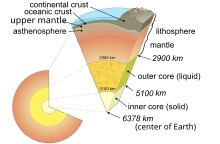 | ||
| Depth[128] (km) |
Component layer name |
Density (g/cm3) |
|---|---|---|
| 0–60 | Lithosphere[n 8]
|
— |
| 0–35 | Crust[n 9] | 2.2–2.9 |
| 35–660 | Upper mantle
|
3.4–4.4 |
| 660–2890 | Lower mantle
|
3.4–5.6 |
| 100–700 | Asthenosphere | — |
| 2890–5100 | Outer core | 9.9–12.2 |
| 5100–6378 | Inner core | 12.8–13.1 |
Earth's interior, like that of the other terrestrial planets, is divided into layers by their
Beneath the lithosphere is the
Among the Solar System's planetary-sized objects Earth is the
Chemical composition
Internal heat
The major heat-producing
The mean heat loss from Earth is 87 mW m−2, for a global heat loss of 4.42×1013 W.[140] A portion of the core's thermal energy is transported toward the crust by mantle plumes, a form of convection consisting of upwellings of higher-temperature rock. These plumes can produce hotspots and flood basalts.[141] More of the heat in Earth is lost through plate tectonics, by mantle upwelling associated with mid-ocean ridges. The final major mode of heat loss is through conduction through the lithosphere, the majority of which occurs under the oceans because the crust there is much thinner than that of the continents.[142]
Gravitational field
The gravity of Earth is the acceleration that is imparted to objects due to the distribution of mass within Earth. Near Earth's surface, gravitational acceleration is approximately 9.8 m/s2 (32 ft/s2). Local differences in topography, geology, and deeper tectonic structure cause local and broad regional differences in Earth's gravitational field, known as gravity anomalies.[143]
Magnetic field
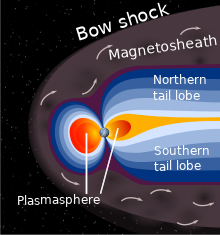
The main part of Earth's magnetic field is generated in the core, the site of a
The extent of Earth's magnetic field in space defines the magnetosphere. Ions and electrons of the solar wind are deflected by the magnetosphere; solar wind pressure compresses the dayside of the magnetosphere, to about 10 Earth radii, and extends the nightside magnetosphere into a long tail.[147] Because the velocity of the solar wind is greater than the speed at which waves propagate through the solar wind, a supersonic bow shock precedes the dayside magnetosphere within the solar wind.[148] Charged particles are contained within the magnetosphere; the plasmasphere is defined by low-energy particles that essentially follow magnetic field lines as Earth rotates.[149][150] The ring current is defined by medium-energy particles that drift relative to the geomagnetic field, but with paths that are still dominated by the magnetic field,[151] and the Van Allen radiation belts are formed by high-energy particles whose motion is essentially random, but contained in the magnetosphere.[152][153]
During
Orbit and rotation
Rotation
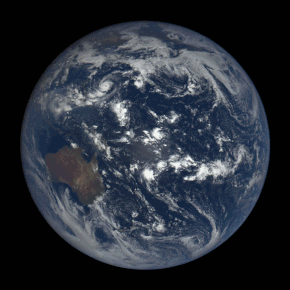
Earth's rotation period relative to the Sun—its mean solar day—is 86,400 seconds of mean solar time (86,400.0025
Earth's rotation period relative to the
Apart from meteors within the atmosphere and low-orbiting satellites, the main apparent motion of celestial bodies in Earth's sky is to the west at a rate of 15°/h = 15'/min. For bodies near the celestial equator, this is equivalent to an apparent diameter of the Sun or the Moon every two minutes; from Earth's surface, the apparent sizes of the Sun and the Moon are approximately the same.[159][160]
Orbit
Earth orbits the Sun, making Earth the third-closest planet to the Sun and part of the
Earth orbits the Sun every 365.2564 mean
The orbital speed of Earth averages about 29.78 km/s (107,200 km/h; 66,600 mph), which is fast enough to travel a distance equal to Earth's diameter, about 12,742 km (7,918 mi), in seven minutes, and the distance to the Moon, 384,000 km (239,000 mi), in about 3.5 hours.[3]
The Moon and Earth orbit a common
The Hill sphere, or the sphere of gravitational influence, of Earth is about 1.5 million km (930,000 mi) in radius.[162][n 11] This is the maximum distance at which Earth's gravitational influence is stronger than the more distant Sun and planets. Objects must orbit Earth within this radius, or they can become unbound by the gravitational perturbation of the Sun.[162] Earth, along with the Solar System, is situated in the Milky Way and orbits about 28,000 light-years from its center. It is about 20 light-years above the galactic plane in the Orion Arm.[163]
Axial tilt and seasons
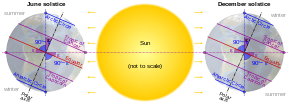
The axial tilt of Earth is approximately 23.439281°
During the summer, the day lasts longer, and the Sun climbs higher in the sky. In winter, the climate becomes cooler and the days shorter.[164] Above the Arctic Circle and below the Antarctic Circle there is no daylight at all for part of the year, causing a polar night, and this night extends for several months at the poles themselves. These same latitudes also experience a midnight sun, where the sun remains visible all day.[165][166]
By astronomical convention, the four seasons can be determined by the solstices—the points in the orbit of maximum axial tilt toward or away from the Sun—and the equinoxes, when Earth's rotational axis is aligned with its orbital axis. In the Northern Hemisphere, winter solstice currently occurs around 21 December; summer solstice is near 21 June, spring equinox is around 20 March and autumnal equinox is about 22 or 23 September. In the Southern Hemisphere, the situation is reversed, with the summer and winter solstices exchanged and the spring and autumnal equinox dates swapped.[167]
The angle of Earth's axial tilt is relatively stable over long periods of time. Its axial tilt does undergo nutation; a slight, irregular motion with a main period of 18.6 years.[168] The orientation (rather than the angle) of Earth's axis also changes over time, precessing around in a complete circle over each 25,800-year cycle; this precession is the reason for the difference between a sidereal year and a tropical year. Both of these motions are caused by the varying attraction of the Sun and the Moon on Earth's equatorial bulge. The poles also migrate a few meters across Earth's surface. This polar motion has multiple, cyclical components, which collectively are termed quasiperiodic motion. In addition to an annual component to this motion, there is a 14-month cycle called the Chandler wobble. Earth's rotational velocity also varies in a phenomenon known as length-of-day variation.[169]
In modern times, Earth's
Earth–Moon system
Moon
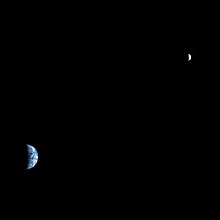

The Moon is a relatively large, terrestrial, planet-like natural satellite, with a diameter about one-quarter of Earth's. It is the largest moon in the Solar System relative to the size of its planet, although Charon is larger relative to the dwarf planet Pluto.[172][173] The natural satellites of other planets are also referred to as "moons", after Earth's.[174] The most widely accepted theory of the Moon's origin, the giant-impact hypothesis, states that it formed from the collision of a Mars-size protoplanet called Theia with the early Earth. This hypothesis explains the Moon's relative lack of iron and volatile elements and the fact that its composition is nearly identical to that of Earth's crust.[40]
The gravitational attraction between Earth and the Moon causes
The Moon may have dramatically affected the development of life by moderating the planet's climate. Paleontological evidence and computer simulations show that Earth's axial tilt is stabilized by tidal interactions with the Moon.[180] Some theorists think that without this stabilization against the torques applied by the Sun and planets to Earth's equatorial bulge, the rotational axis might be chaotically unstable, exhibiting large changes over millions of years, as is the case for Mars, though this is disputed.[181][182]
Viewed from Earth, the Moon is just far enough away to have almost the same apparent-sized disk as the Sun. The
On 1 November 2023, scientists reported that, according to computer simulations, remnants of a protoplanet, named Theia, could be inside the Earth, left over from a collision with the Earth in ancient times, and afterwards becoming the Moon.[184][185]
Asteroids and artificial satellites
Earth's
As of September 2021[update], there are 4,550 operational, human-made satellites orbiting Earth.[190] There are also inoperative satellites, including Vanguard 1, the oldest satellite currently in orbit, and over 16,000 pieces of tracked space debris.[n 13] Earth's largest artificial satellite is the International Space Station.[191]
Hydrosphere
Earth's hydrosphere is the sum of Earth's water and its distribution. Most of Earth's hydrosphere consists of Earth's global ocean. Earth's hydrosphere also consists of water in the atmosphere and on land, including clouds, inland seas, lakes, rivers, and underground waters down to a depth of 2,000 m (6,600 ft).[citation needed]
The mass of the oceans is approximately 1.35×1018
In Earth's coldest regions, snow survives over the summer and
The average
The abundance of water, particularly liquid water, on Earth's surface is a unique feature that distinguishes it from other planets in the Solar System. Solar System planets with considerable atmospheres do partly host atmospheric water vapor, but they lack surface conditions for stable surface water.[207] Despite some moons showing signs of large reservoirs of extraterrestrial liquid water, with possibly even more volume than Earth's ocean, all of them are large bodies of water under a kilometers thick frozen surface layer.[208]
Atmosphere
The atmospheric pressure at Earth's sea level averages 101.325 kPa (14.696 psi),[209] with a scale height of about 8.5 km (5.3 mi).[3] A dry atmosphere is composed of 78.084% nitrogen, 20.946% oxygen, 0.934% argon, and trace amounts of carbon dioxide and other gaseous molecules.[209] Water vapor content varies between 0.01% and 4%[209] but averages about 1%.[3] Clouds cover around two-thirds of Earth's surface, more so over oceans than land.[210] The height of the troposphere varies with latitude, ranging between 8 km (5 mi) at the poles to 17 km (11 mi) at the equator, with some variation resulting from weather and seasonal factors.[211]
Earth's
Weather and climate
Earth's atmosphere has no definite boundary, gradually becoming thinner and fading into outer space.[216] Three-quarters of the atmosphere's mass is contained within the first 11 km (6.8 mi) of the surface; this lowest layer is called the troposphere.[217] Energy from the Sun heats this layer, and the surface below, causing expansion of the air. This lower-density air then rises and is replaced by cooler, higher-density air. The result is atmospheric circulation that drives the weather and climate through redistribution of thermal energy.[218]
The primary atmospheric circulation bands consist of the trade winds in the equatorial region below 30° latitude and the westerlies in the mid-latitudes between 30° and 60°.[219] Ocean heat content and currents are also important factors in determining climate, particularly the thermohaline circulation that distributes thermal energy from the equatorial oceans to the polar regions.[220]
Earth receives 1361 W/m2 of
Further factors that affect a location's climates are its
Water vapor generated through surface evaporation is transported by circulatory patterns in the atmosphere. When atmospheric conditions permit an uplift of warm, humid air, this water condenses and falls to the surface as precipitation.[218] Most of the water is then transported to lower elevations by river systems and usually returned to the oceans or deposited into lakes. This water cycle is a vital mechanism for supporting life on land and is a primary factor in the erosion of surface features over geological periods. Precipitation patterns vary widely, ranging from several meters of water per year to less than a millimeter. Atmospheric circulation, topographic features, and temperature differences determine the average precipitation that falls in each region.[229]
The commonly used
Upper atmosphere
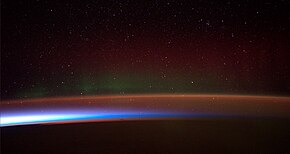
The upper atmosphere, the atmosphere above the troposphere,[233] is usually divided into the stratosphere, mesosphere, and thermosphere.[213] Each layer has a different lapse rate, defining the rate of change in temperature with height. Beyond these, the exosphere thins out into the magnetosphere, where the geomagnetic fields interact with the solar wind.[234] Within the stratosphere is the ozone layer, a component that partially shields the surface from ultraviolet light and thus is important for life on Earth. The Kármán line, defined as 100 km (62 mi) above Earth's surface, is a working definition for the boundary between the atmosphere and outer space.[235]
Thermal energy causes some of the molecules at the outer edge of the atmosphere to increase their velocity to the point where they can escape from Earth's gravity. This causes a slow but steady loss of the atmosphere into space. Because unfixed hydrogen has a low molecular mass, it can achieve escape velocity more readily, and it leaks into outer space at a greater rate than other gases.[236] The leakage of hydrogen into space contributes to the shifting of Earth's atmosphere and surface from an initially reducing state to its current oxidizing one. Photosynthesis provided a source of free oxygen, but the loss of reducing agents such as hydrogen is thought to have been a necessary precondition for the widespread accumulation of oxygen in the atmosphere.[237] Hence the ability of hydrogen to escape from the atmosphere may have influenced the nature of life that developed on Earth.[238] In the current, oxygen-rich atmosphere most hydrogen is converted into water before it has an opportunity to escape. Instead, most of the hydrogen loss comes from the destruction of methane in the upper atmosphere.[239]
Life on Earth
Earth is the only known place that has ever been habitable for life. Earth's life developed in Earth's early bodies of water some hundred million years after Earth formed.[citation needed]
Earth's life has been shaping and inhabiting many particular ecosystems on Earth and has eventually expanded globally forming an overarching biosphere.[240] Therefore, life has impacted Earth, significantly altering Earth's atmosphere and surface over long periods of time, causing changes like the Great Oxidation Event.[241]
Earth's life has over time greatly diversified, allowing the biosphere to have different
Earth provides liquid water—an environment where complex organic molecules can assemble and interact, and sufficient energy to sustain a metabolism.[244] Plants and other organisms take up nutrients from water, soils and the atmosphere. These nutrients are constantly recycled between different species.[245]

Extreme weather, such as
Human geography
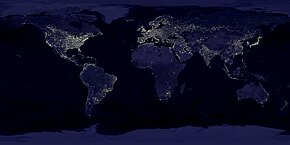
Originating from earlier primates in Eastern Africa 300,000 years ago humans have since been migrating and with the advent of agriculture in the 10th millennium BC increasingly settling Earth's land.[251] In the 20th century Antarctica had been the last continent to see a first and until today limited human presence.[citation needed]
Human population has since the 19th century grown exponentially to seven billion in the early 2010s,[252] and is projected to peak at around ten billion in the second half of the 21st century.[253] Most of the growth is expected to take place in sub-Saharan Africa.[253]
Distribution and
Beyond Earth's surface humans have lived on a temporary basis, with only special purpose deep
Earth has been subject to extensive human settlement, and humans have developed diverse societies and cultures. Most of Earth's land has been territorially claimed since the 19th century by
Natural resources and land use

Earth has resources that have been exploited by humans.[262] Those termed non-renewable resources, such as fossil fuels, are only replenished over geological timescales.[263] Large deposits of fossil fuels are obtained from Earth's crust, consisting of coal, petroleum, and natural gas.[264] These deposits are used by humans both for energy production and as feedstock for chemical production.[265] Mineral ore bodies have also been formed within the crust through a process of ore genesis, resulting from actions of magmatism, erosion, and plate tectonics.[266] These metals and other elements are extracted by mining, a process which often brings environmental and health damage.[267]
Earth's biosphere produces many useful biological products for humans, including food, wood,
Humans and the environment

Human activities have impacted Earth's environments. Through activities such as the burning of fossil fuels, humans have been increasing the amount of
The concept of planetary boundaries was introduced to quantify humanity's impact on Earth. Of the nine identified boundaries, five have been crossed: Biosphere integrity, climate change, chemical pollution, destruction of wild habitats and the nitrogen cycle are thought to have passed the safe threshold.[275][276] As of 2018, no country meets the basic needs of its population without transgressing planetary boundaries. It is thought possible to provide all basic physical needs globally within sustainable levels of resource use.[277]
Cultural and historical viewpoint

Images of Earth taken from space, particularly during the Apollo program, have been credited with altering the way that people viewed the planet that they lived on, called the overview effect, emphasizing its beauty, uniqueness and apparent fragility.[284][285] In particular, this caused a realization of the scope of effects from human activity on Earth's environment. Enabled by science, particularly Earth observation,[286] humans have started to take action on environmental issues globally,[287] acknowledging the impact of humans and the interconnectedness of Earth's environments.[citation needed]
Scientific investigation has resulted in several culturally transformative shifts in people's view of the planet. Initial belief in a flat Earth was gradually displaced in Ancient Greece by the idea of a spherical Earth, which was attributed to both the philosophers Pythagoras and Parmenides.[288][289] Earth was generally believed to be the center of the universe until the 16th century, when scientists first concluded that it was a moving object, one of the planets of the Solar System.[290]
It was only during the 19th century that geologists realized
See also
- Celestial sphere
- Earth phase
- Earth science
- Extremes on Earth
- List of Solar System extremes
- Outline of Earth
- Table of physical properties of planets in the Solar System
- Timeline of the far future
Notes
- J2000.0of the secular variation, ignoring all periodic variations.
- ISBN 978-0-643-09949-4.
- ^ Earth's circumference is almost exactly 40,000 km because the meter was calibrated on this measurement—more specifically, 1/10-millionth of the distance between the poles and the equator.
- ^ Due to natural fluctuations, ambiguities surrounding ice shelves, and mapping conventions for vertical datums, exact values for land and ocean coverage are not meaningful. Based on data from the Vector Map and Global Landcover Archived 26 March 2015 at the Wayback Machine datasets, extreme values for coverage of lakes and streams are 0.6% and 1.0% of Earth's surface. The ice sheets of Antarctica and Greenland are counted as land, even though much of the rock that supports them lies below sea level.
- ^ Source for minimum,[19] mean,[20] and maximum[21] surface temperature
- ^ If Earth were shrunk to the size of a billiard ball, some areas of Earth such as large mountain ranges and oceanic trenches would feel like tiny imperfections, whereas much of the planet, including the Great Plains and the abyssal plains, would feel smoother.[90]
- .
- ^ Locally varies between 5 and 200 km.
- ^ Locally varies between 5 and 70 km.
- Bibcode:1982A&A...105..359A.
- Hill radiusis , where m is the mass of Earth, a is an astronomical unit, and M is the mass of the Sun. So the radius in AU is about .
- ^ Aphelion is 103.4% of the distance to perihelion. Due to the inverse square law, the radiation at perihelion is about 106.9% of the energy at aphelion.
- ^ As of 4 January 2018, the United States Strategic Command tracked a total of 18,835 artificial objects, mostly debris. See: Anz-Meador, Phillip; Shoots, Debi, eds. (February 2018). "Satellite Box Score" (PDF). Orbital Debris Quarterly News. 22 (1): 12. Retrieved 18 April 2018.
References
- ^ Bibcode:1994A&A...282..663S.
- ^ a b c d e Staff (13 March 2021). "Useful Constants". International Earth Rotation and Reference Systems Service. Retrieved 8 June 2022.
- ^ a b c d e f g h i j k l m Williams, David R. (16 March 2017). "Earth Fact Sheet". NASA/Goddard Space Flight Center. Retrieved 26 July 2018.
- ISBN 978-0-387-98746-0. Retrieved 13 March 2011.
- ^ Park, Ryan (9 May 2022). "Horizons Batch Call for 2023 Perihelion". NASA/JPL. Retrieved 3 July 2022.
- ISBN 978-0-8493-0481-1.
- ^ "Selected Astronomical Constants, 2011". The Astronomical Almanac. Archived from the original on 26 August 2013. Retrieved 25 February 2011.
- ^ a b World Geodetic System (WGS-84). Available online Archived 11 March 2020 at the Wayback Machine from National Geospatial-Intelligence Agency.
- ISBN 978-3-89888-884-4. Retrieved 29 April 2016.
- ^ Humerfelt, Sigurd (26 October 2010). "How WGS 84 defines Earth". Home Online. Archived from the original on 24 April 2011. Retrieved 29 April 2011.
- ^ a b Pidwirny, Michael (2 February 2006). "Surface area of our planet covered by oceans and continents.(Table 8o-1)". University of British Columbia, Okanagan. Retrieved 26 November 2007.
- ^ "Planetary Physical Parameters". Jet Propulsion Laboratory. 2008. Retrieved 11 August 2022.
- ^ The international system of units (SI) (PDF) (2008 ed.). United States Department of Commerce, NIST Special Publication 330. p. 52. Archived from the original (PDF) on 5 February 2009.
- S2CID 122370108.
- ISBN 978-0-387-98746-0. Retrieved 17 August 2010.
- ISBN 978-0-387-98746-0. Retrieved 17 August 2010.
- ^ "Atmospheres and Planetary Temperatures". American Chemical Society. 18 July 2013. Archived from the original on 27 January 2023. Retrieved 3 January 2023.
- WMO Weather and Climate Extremes Archive. Arizona State University. Retrieved 6 September 2020.
- ISSN 2169-8996.
- WMO Weather and Climate Extremes Archive. Arizona State University. Retrieved 6 September 2020.
- ISBN 978-92-1-142274-0. Retrieved 9 November 2012.
- ^ "What Is Climate Change?". United Nations. Retrieved 17 August 2022.
- ^ ISBN 978-0-19-957112-3.
- ISBN 978-0-85991-513-7.
- ISBN 978-0-19-861263-6.
- ^ "Terra". Oxford English Dictionary (Online ed.). Oxford University Press. (Subscription or participating institution membership required.)
- ^ "Tellus". Oxford English Dictionary (Online ed.). Oxford University Press. (Subscription or participating institution membership required.)
- ^ "Gaia". Oxford English Dictionary (Online ed.). Oxford University Press. (Subscription or participating institution membership required.)
- ^ "Terran". Oxford English Dictionary (Online ed.). Oxford University Press. (Subscription or participating institution membership required.)
- ^ "terrestrial". Oxford English Dictionary (Online ed.). Oxford University Press. (Subscription or participating institution membership required.)
- ^ "terrene". Oxford English Dictionary (Online ed.). Oxford University Press. (Subscription or participating institution membership required.)
- ^ "tellurian". Oxford English Dictionary (Online ed.). Oxford University Press. (Subscription or participating institution membership required.)
- ^ "telluric". Lexico UK English Dictionary. Oxford University Press. Archived from the original on 31 March 2021.
- doi:10.1038/ngeo941.
- ^ See:
- ISBN 978-0-8047-1569-0.
- Newman, William L. (9 July 2007). "Age of the Earth". Publications Services, USGS. Retrieved 20 September 2007.
- S2CID 130092094. Retrieved 20 September 2007.
- Bibcode:2018LPICo2084.4034R. Retrieved 25 October 2020.
- ISSN 1572-9672.
- ^ Reilly, Michael (22 October 2009). "Controversial Moon Origin Theory Rewrites History". Discovery News. Archived from the original on 9 January 2010. Retrieved 30 January 2010.
- ^ S2CID 4413525.
- S2CID 119226112.
- ISBN 978-3-642-11271-3.
- ^ "Earth's Early Atmosphere and Oceans". Lunar and Planetary Institute. Universities Space Research Association. Retrieved 27 June 2019.
- .
- S2CID 221342529.
- ISBN 978-1-58381-109-2.
- ^ Staff (4 March 2010). "Oldest measurement of Earth's magnetic field reveals battle between Sun and Earth for our atmosphere". Phys.org. Retrieved 27 March 2010.
- PMID 17101962.
- ^ .
- ^ S2CID 11208727.
- ISBN 978-0-19-516589-0.
- PMID 17772560.
- .
- hdl:1874/1653.
- PMID 30275156.
- S2CID 140601854.
- ^ Kinzler, Ro. "When and how did the ice age end? Could another one start?". Ology. American Museum of Natural History. Retrieved 27 June 2019.
- PMID 29180424.
- ^ Staff. "Paleoclimatology – The Study of Ancient Climates". Page Paleontology Science Center. Archived from the original on 4 March 2007. Retrieved 2 March 2007.
- . Retrieved 3 November 2020.
- PMID 10710791. Archived from the original(PDF) on 15 July 2011.
- ^ a b Zimmer, Carl (3 October 2013). "Earth's Oxygen: A Mystery Easy to Take for Granted". The New York Times. Archived from the original on 3 October 2013. Retrieved 3 October 2013.
- .
- ^ Burton, Kathleen (29 November 2002). "Astrobiologists Find Evidence of Early Life on Land". NASA. Archived from the original on 11 October 2011. Retrieved 5 March 2007.
- PMID 24205812.
- S2CID 54767854.
- ^ Borenstein, Seth (19 October 2015). "Hints of life on what was thought to be desolate early Earth". Excite. Yonkers, NY: Mindspark Interactive Network. Associated Press. Archived from the original on 18 August 2016. Retrieved 20 October 2015.
- PMID 26483481. Early edition, published online before print.
- ^ Tyrell, Kelly April (18 December 2017). "Oldest fossils ever found show life on Earth began before 3.5 billion years ago". University of Wisconsin–Madison. Retrieved 18 December 2017.
- PMID 29255053.
- ^ "Earth-Moon Dynamics". Lunar and Planetary Institute. Retrieved 2 September 2022.
- ISBN 978-0-521-87164-8.
- ISBN 978-0-12-814312-4.
- S2CID 23599425.
- PMID 7939569. Retrieved 5 March 2007.
- PMID 36002567.
- S2CID 128776283.
- ^ doi:10.1086/173407.
- ^ Britt, Robert (25 February 2000). "Freeze, Fry or Dry: How Long Has the Earth Got?". Space.com. Archived from the original on 5 June 2009.
- PMID 19487662. Retrieved 19 July 2009.
- ISBN 978-0-8050-6781-1.
- ^ ISSN 1473-5504.
- S2CID 14024675.
- S2CID 10073988.on 15 April 2012. Retrieved 24 March 2008.
See also Palmer, Jason (22 February 2008). "Hope dims that Earth will survive Sun's death". NewScientist.com news service. Archived from the original - ^ Horner, Jonti (16 July 2021). "I've always wondered: why are the stars, planets and moons round, when comets and asteroids aren't?". The Conversation. Retrieved 3 March 2023.
- ^ Lea, Robert (6 July 2021). "How big is Earth?". Space.com. Archived from the original on 9 January 2024. Retrieved 11 January 2024.
- ^ a b Sandwell, D. T.; Smith, Walter H. F. (7 July 2006). "Exploring the Ocean Basins with Satellite Altimeter Data". NOAA/NGDC. Archived from the original on 15 July 2014. Retrieved 21 April 2007.
- ^ Milbert, D. G.; Smith, D. A. "Converting GPS Height into NAVD88 Elevation with the GEOID96 Geoid Height Model". National Geodetic Survey, NOAA. Retrieved 7 March 2007.
- ISSN 0012-8252.
- ^ "Is a Pool Ball Smoother than the Earth?" (PDF). Billiards Digest. 1 June 2013. Retrieved 26 November 2014.
- ^ Tewksbury, Barbara. "Back-of-the-Envelope Calculations: Scale of the Himalayas". Carleton University. Retrieved 19 October 2020.
- ^ Senne, Joseph H. (2000). "Did Edmund Hillary Climb the Wrong Mountain". Professional Surveyor. 20 (5): 16–21. Archived from the original on 17 July 2015. Retrieved 16 July 2015.
- ^ Krulwich, Robert (7 April 2007). "The 'Highest' Spot on Earth". NPR. Retrieved 31 July 2012.
- ^ "Ocean Surface Topography". Ocean Surface Topography from Space. NASA. Retrieved 16 June 2022.
- ^ "What is the geoid?". National Ocean Service. Retrieved 10 October 2020.
- ^ "8(o) Introduction to the Oceans". www.physicalgeography.net.
- ISBN 978-0-7864-5956-8. Retrieved 26 August 2022.
- ^ Ro, Christine (3 February 2020). "Is It Ocean Or Oceans?". Forbes. Retrieved 26 August 2022.
- ^ Smith, Yvette (7 June 2021). "Earth Is a Water World". NASA. Retrieved 27 August 2022.
- ^ "Water-Worlds". National Geographic Society. 20 May 2022. Retrieved 24 August 2022.
- ISSN 0094-5765.
- ^ "Ocean Worlds". Ocean Worlds. Archived from the original on 27 August 2022. Retrieved 27 August 2022.
- S2CID 241687784.
- ISBN 978-0-520-28989-5.
- ^ Dempsey, Caitlin (15 October 2013). "Geography Facts about the World's Continents". Geography Realm. Retrieved 26 August 2022.
- ISBN 978-0-8160-7229-3. Retrieved 25 August 2022.
And since Africa and Asia are connected at the Suez Peninsula, Europe, Africa, and Asia are sometimes combined as Afro-Eurasia or Eurafrasia. The International Olympic Committee's official flag, containing [...] the single continent of America (North and South America being connected as the Isthmus of Panama).
- ^ Center, National Geophysical Data (19 August 2020). "Hypsographic Curve of Earth's Surface from ETOPO1". ngdc.noaa.gov.
- ^ Carlowicz, Michael; Simmon, Robert (15 July 2019). "Seeing Forests for the Trees and the Carbon: Mapping the World's Forests in Three Dimensions". NASA Earth Observatory. Retrieved 31 December 2022.
- ^ "Ice Sheet". National Geographic Society. 6 August 2006. Retrieved 3 January 2023.
- S2CID 235532921.
- ^ Cain, Fraser (1 June 2010). "What Percentage of the Earth's Land Surface is Desert?". Universe Today. Retrieved 3 January 2023.
- ^ "World Bank arable land". World Bank. Retrieved 19 October 2015.
- ^ "World Bank permanent cropland". World Bank. Retrieved 19 October 2015.
- .
- ^ Staff. "Layers of the Earth". Volcano World. Oregon State University. Archived from the original on 11 February 2013. Retrieved 11 March 2007.
- ^ Jessey, David. "Weathering and Sedimentary Rocks". California State Polytechnic University, Pomona. Archived from the original on 3 July 2007. Retrieved 20 March 2007.
- ^ Kring, David A. "Terrestrial Impact Cratering and Its Environmental Effects". Lunar and Planetary Laboratory. Retrieved 22 March 2007.
- OCLC 635476788.
- ^ Brown, W. K.; Wohletz, K. H. (2005). "SFT and the Earth's Tectonic Plates". Los Alamos National Laboratory. Retrieved 2 March 2007.
- ^ Kious, W. J.; Tilling, R. I. (5 May 1999). "Understanding plate motions". USGS. Retrieved 2 March 2007.
- ^ Seligman, Courtney (2008). "The Structure of the Terrestrial Planets". Online Astronomy eText Table of Contents. cseligman.com. Retrieved 28 February 2008.
- ^ Duennebier, Fred (12 August 1999). "Pacific Plate Motion". University of Hawaii. Retrieved 14 March 2007.
- ^ Mueller, R. D.; et al. (7 March 2007). "Age of the Ocean Floor Poster". NOAA. Retrieved 14 March 2007.
- S2CID 128376754.
- ^ Meschede, Martin; Barckhausen, Udo (20 November 2000). "Plate Tectonic Evolution of the Cocos-Nazca Spreading Center". Proceedings of the Ocean Drilling Program. Texas A&M University. Retrieved 2 April 2007.
- .
- PMID 16592703.
- ^ Robertson, Eugene C. (26 July 2001). "The Interior of the Earth". USGS. Retrieved 24 March 2007.
- ^ "The Crust and Lithosphere". London Geological Society. 2012. Retrieved 25 October 2020.
- ^ Micalizio, Caryl-Sue; Evers, Jeannie (20 May 2015). "Lithosphere". National Geographic. Retrieved 13 October 2020.
- ISBN 978-0-87590-851-9. Archived from the original(PDF) on 16 October 2006. Retrieved 3 February 2007.
- .
- ^ PMID 16592930.
- ISBN 978-0-04-550028-4. Note: After Ronov and Yaroshevsky (1969).
- ^ Sanders, Robert (10 December 2003). "Radioactive potassium may be major heat source in Earth's core". UC Berkeley News. Retrieved 28 February 2007.
- ^ "The Earth's Centre is 1000 Degrees Hotter than Previously Thought". The European Synchrotron (ESRF). 25 April 2013. Archived from the original on 28 June 2013. Retrieved 12 April 2015.
- S2CID 21132433. Retrieved 28 February 2007.
- ISBN 978-0-521-66624-4.
- doi:10.1016/0012-821X(94)90028-0. Archived from the original(PDF) on 19 March 2012.
- .
- S2CID 9147772.
- .
- .
- S2CID 22283432.
- ^ Fitzpatrick, Richard (16 February 2006). "MHD dynamo theory". NASA WMAP. Retrieved 27 February 2007.
- ISBN 978-0-521-82206-0.
- S2CID 134666611. Archived from the originalon 31 March 2021. Retrieved 24 October 2020.
- ^ Masson, Arnaud (11 May 2007). "Cluster reveals the reformation of the Earth's bow shock". European Space Agency. Retrieved 16 August 2016.
- ^ Gallagher, Dennis L. (14 August 2015). "The Earth's Plasmasphere". NASA/Marshall Space Flight Center. Retrieved 16 August 2016.
- ^ Gallagher, Dennis L. (27 May 2015). "How the Plasmasphere is Formed". NASA/Marshall Space Flight Center. Archived from the original on 15 November 2016. Retrieved 16 August 2016.
- ISBN 978-1-86094-079-8.
- ^ McElroy, Michael B. (2012). "Ionosphere and magnetosphere". Encyclopædia Britannica. Encyclopædia Britannica, Inc.
- OCLC 646887856.
- ^ Stern, David P. (8 July 2005). "Exploration of the Earth's Magnetosphere". NASA. Archived from the original on 14 February 2013. Retrieved 21 March 2007.
- .
- ^ "Leap seconds". Time Service Department, USNO. Archived from the original on 12 March 2015. Retrieved 23 September 2008.
- ^ "Rapid Service/Prediction of Earth Orientation". IERS Bulletin-A. 28 (15). 9 April 2015. Archived from the original (.DAT file (displays as plaintext in browser)) on 14 March 2015. Retrieved 12 April 2015.
- ISBN 978-0-935702-68-2.
- ISBN 978-0-03-006228-5.
- ^ a b Williams, David R. (10 February 2006). "Planetary Fact Sheets". NASA. See the apparent diameters on the Sun and Moon pages. Retrieved 28 September 2008.
- ^ Williams, David R. (1 September 2004). "Moon Fact Sheet". NASA. Retrieved 21 March 2007.
- ^ Bibcode:2006LNEA....2...49V. Archived from the original(PDF) on 17 August 2011. Retrieved 21 March 2007.
- ^ Astrophysicist team (1 December 2005). "Earth's location in the Milky Way". NASA. Archived from the original on 1 July 2008. Retrieved 11 June 2008.
- ISBN 978-1-284-12656-3.
- ^ Burn, Chris (March 1996). The Polar Night (PDF). The Aurora Research Institute. Retrieved 28 September 2015.
- ^ "Sunlight Hours". Australian Antarctic Programme. 24 June 2020. Retrieved 13 October 2020.
- ^ Bromberg, Irv (1 May 2008). "The Lengths of the Seasons (on Earth)". Sym545. University of Toronto. Archived from the original on 18 December 2008. Retrieved 8 November 2008.
- ^ Lin, Haosheng (2006). "Animation of precession of moon orbit". Survey of Astronomy AST110-6. University of Hawaii at Manoa. Retrieved 10 September 2010.
- ^ Fisher, Rick (5 February 1996). "Earth Rotation and Equatorial Coordinates". National Radio Astronomy Observatory. Archived from the original on 18 August 2011. Retrieved 21 March 2007.
- ^ Buis, Alan (27 February 2020). "Milankovitch (Orbital) Cycles and Their Role in Earth's Climate". NASA. Retrieved 27 October 2020.
- ^ Kang, Sarah M.; Seager, Richard. "Croll Revisited: Why is the Northern Hemisphere Warmer than the Southern Hemisphere?" (PDF). Columbia University. New York. Retrieved 27 October 2020.
- ^ Klemetti, Erik (17 June 2019). "What's so special about our Moon, anyway?". Astronomy. Retrieved 13 October 2020.
- ^ "Charon". NASA. 19 December 2019. Retrieved 13 October 2020.
- ^ Brown, Toby (2 December 2019). "Curious Kids: Why is the moon called the moon?". The Conversation. Retrieved 13 October 2020.
- ISSN 0012-8252.
- ^ Kelley, Peter (17 August 2017). "Tidally locked exoplanets may be more common than previously thought". Uw News. Retrieved 8 October 2020.
- ^ "Lunar Phases and Eclipses | Earth's Moon". NASA Solar System Exploration. Retrieved 8 October 2020.
- ^ Espenak, Fred; Meeus, Jean (7 February 2007). "Secular acceleration of the Moon". NASA. Archived from the original on 2 March 2008. Retrieved 20 April 2007.
- S2CID 51948507.
- .
- ^ Cooper, Keith (27 January 2015). "Earth's moon may not be critical to life". Phys.org. Retrieved 26 October 2020.
- doi:10.1016/j.icarus.2007.10.017. Archived from the original(PDF) on 1 December 2020. Retrieved 26 October 2020.
- ^ Sharf, Caleb A. (18 May 2012). "The Solar Eclipse Coincidence". Scientific American. Retrieved 13 October 2020.
- ^ Chang, Kenneth (1 November 2023). "A 'Big Whack' Formed the Moon and Left Traces Deep in Earth, a Study Suggests - Two enormous blobs deep inside Earth could be remnants of the birth of the moon". The New York Times. Archived from the original on 1 November 2023. Retrieved 2 November 2023.
- from the original on 2 November 2023. Retrieved 2 November 2023.
- S2CID 13832179. See table 2, p. 5.
- S2CID 118580771. Retrieved 28 October 2020.
- ^ Choi, Charles Q. (27 July 2011). "First Asteroid Companion of Earth Discovered at Last". Space.com. Retrieved 27 July 2011.
- ^ "2006 RH120 ( = 6R10DB9) (A second moon for the Earth?)". Great Shefford Observatory. Archived from the original on 6 February 2015. Retrieved 17 July 2015.
- ^ "UCS Satellite Database". Nuclear Weapons & Global Security. Union of Concerned Scientists. 1 September 2021. Retrieved 12 January 2022.
- ISBN 978-1-61069-094-2.
- hdl:1912/3862.
- ^ "Third rock from the Sun – restless Earth". NASA's Cosmos. Retrieved 12 April 2015.
- ISBN 9789286143199. Retrieved 7 December 2020.
- ^ Khokhar, Tariq (22 March 2017). "Chart: Globally, 70% of Freshwater is Used for Agriculture". World Bank Blogs. Retrieved 7 December 2020.
- ^ Perlman, Howard (17 March 2014). "The World's Water". USGS Water-Science School. Retrieved 12 April 2015.
- ^ "Where Are Lakes?". Lake Scientist. 28 February 2016. Retrieved 28 February 2023.
- ^ School, Water Science (13 November 2019). "How Much Water is There on Earth? – U.S. Geological Survey". USGS.gov. Retrieved 3 March 2023.
- ^ "Freshwater Resources". Education. 18 August 2022. Retrieved 28 February 2023.
- ISBN 978-0-357-11656-2.
- ISBN 978-0-357-11656-2.
- ISBN 978-0-8493-2391-1.
- ^ Mullen, Leslie (11 June 2002). "Salt of the Early Earth". NASA Astrobiology Magazine. Archived from the original on 30 June 2007. Retrieved 14 March 2007.
- ^ Morris, Ron M. "Oceanic Processes". NASA Astrobiology Magazine. Archived from the original on 15 April 2009. Retrieved 14 March 2007.
- ^ Scott, Michon (24 April 2006). "Earth's Big heat Bucket". NASA Earth Observatory. Retrieved 14 March 2007.
- ^ Sample, Sharron (21 June 2005). "Sea Surface Temperature". NASA. Archived from the original on 27 April 2013. Retrieved 21 April 2007.
- ^ Center, Astrogeology Science (14 October 2021). "Tour of Water in the Solar System – U.S. Geological Survey". USGS.gov. Retrieved 19 January 2022.
- ^ "Are there oceans on other planets?". NOAA's National Ocean Service. 1 June 2013. Retrieved 19 January 2022.
- ^ a b c Exline, Joseph D.; Levine, Arlene S.; Levine, Joel S. (2006). Meteorology: An Educator's Resource for Inquiry-Based Learning for Grades 5–9 (PDF). NASA/Langley Research Center. p. 6. NP-2006-08-97-LaRC.
- S2CID 206691291.
- ^ Geerts, B.; Linacre, E. (November 1997). "The height of the tropopause". Resources in Atmospheric Sciences. University of Wyoming. Retrieved 10 August 2006.
- ISBN 978-0-85404-265-4.
- ^ a b Staff (8 October 2003). "Earth's Atmosphere". NASA. Archived from the original on 27 April 2020. Retrieved 21 March 2007.
- ^ Pidwirny, Michael (2006). "Fundamentals of Physical Geography (2nd Edition)". University of British Columbia, Okanagan. Retrieved 19 March 2007.
- ISBN 978-81-7835-641-9.
- ^ Drake, Nadia (20 December 2018). "Where, exactly, is the edge of space? It depends on who you ask". National Geographic. Archived from the original on 4 March 2021. Retrieved 4 December 2021.
- ^ Erickson, Kristen; Doyle, Heather (28 June 2019). "Troposphere". SpacePlace. NASA. Retrieved 4 December 2021.
- ^ a b Moran, Joseph M. (2005). "Weather". World Book Online Reference Center. NASA/World Book, Inc. Archived from the original on 13 December 2010. Retrieved 17 March 2007.
- ^ a b Berger, Wolfgang H. (2002). "The Earth's Climate System". University of California, San Diego. Retrieved 24 March 2007.
- ^ Rahmstorf, Stefan (2003). "The Thermohaline Ocean Circulation". Potsdam Institute for Climate Impact Research. Retrieved 21 April 2007.
- ^ "Earth Fact Sheet". NASA Space Science Data Coordinated Archive. 5 June 2023. Retrieved 17 September 2023.
- .
- ISBN 978-0-7167-7671-0.
- ^ Staff. "Climate Zones". UK Department for Environment, Food and Rural Affairs. Archived from the original on 8 August 2010. Retrieved 24 March 2007.
- ISBN 978-1-284-12656-3.
- ISBN 978-1-284-12656-3.
- ISBN 978-1-284-12656-3.
- ISBN 978-1-284-12656-3.
- ^ Various (21 July 1997). "The Hydrologic Cycle". University of Illinois. Retrieved 24 March 2007.
- ISBN 978-1-284-12656-3.
- ISSN 0003-0007.
- ISSN 2156-2202.
- ^ Morton, Oliver (26 August 2022). "Upper atmosphere Definition und Bedeutung". Collins Wörterbuch (in German). Retrieved 26 August 2022.
- ^ Staff (2004). "Stratosphere and Weather; Discovery of the Stratosphere". Science Week. Archived from the original on 13 July 2007. Retrieved 14 March 2007.
- ^ de Córdoba, S. Sanz Fernández (21 June 2004). "Presentation of the Karman separation line, used as the boundary separating Aeronautics and Astronautics". Fédération Aéronautique Internationale. Archived from the original on 15 January 2010. Retrieved 21 April 2007.
- .
- S2CID 37386726.
- ^ Abedon, Stephen T. (31 March 1997). "History of Earth". Ohio State University. Archived from the original on 29 November 2012. Retrieved 19 March 2007.
- .
- ^ Rutledge, Kim; et al. (24 June 2011). "Biosphere". National Geographic. Retrieved 1 November 2020.
- ^ "NASA Astrobiology Institute". astrobiology.nasa.gov. Retrieved 9 November 2023.
- ^ "Interdependency between animal and plant species". BBC Bitesize. BBC. p. 3. Retrieved 28 June 2019.
- S2CID 9886026.
- ^ Staff (September 2003). "Astrobiology Roadmap". NASA, Lockheed Martin. Archived from the original on 12 March 2012. Retrieved 10 March 2007.
- OCLC 896866658.
- ISBN 978-0-08-087782-2.
- ISBN 978-1-317-93881-1.
- ISBN 978-0-262-57138-8.
- ^ ISSN 1748-9326.
- ^ a b "Global Warming Effects". National Geographic. 14 January 2019. Archived from the original on 18 January 2017. Retrieved 16 September 2020.
- ^ "Introduction to Human Evolution | The Smithsonian Institution's Human Origins Program". humanorigins.si.edu. 11 July 2022. Retrieved 9 November 2023.
- ^ Gomez, Jim; Sullivan, Tim (31 October 2011). "Various '7 billionth' babies celebrated worldwide". Yahoo News. Associated Press. Archived from the original on 31 October 2011. Retrieved 31 October 2011.
- ^ ISSN 0261-3077. Retrieved 18 September 2020.
- ^ Lutz, Ashley (4 May 2012). "MAP OF THE DAY: Pretty Much Everyone Lives In The Northern Hemisphere". Business Insider. Retrieved 5 January 2019.
- ^ Méndez, Abel (6 July 2011). "Distribution of landmasses of the Paleo-Earth". University of Puerto Rico at Arecibo. Archived from the original on 6 January 2019. Retrieved 5 January 2019.
- ^ Ritchie, H.; Roser, M. (2019). "What share of people will live in urban areas in the future?". Our World in Data. Retrieved 26 October 2020.
- ISBN 978-0-387-21894-6.
- ISSN 0261-3077. Retrieved 10 October 2020.
- ^ "Member States | United Nations". United Nations. Archived from the original on 1 March 2023. Retrieved 3 January 2024.
- ISBN 978-0-571-29072-7.
- ISBN 978-1-58826-323-0.
- ^ "What are the consequences of the overexploitation of natural resources?". Iberdrola. Retrieved 28 June 2019.
- ^ "13. Exploitation of Natural Resources". European Environment Agency. European Union. 20 April 2016. Retrieved 28 June 2019.
- ^ Huebsch, Russell (29 September 2017). "How Are Fossil Fuels Extracted From the Ground?". Sciencing. Leaf Group Media. Retrieved 28 June 2019.
- ^ "Electricity generation – what are the options?". World Nuclear Association. Retrieved 28 June 2019.
- JSTOR 24936905. Retrieved 13 October 2020.
- ISBN 978-0-521-61519-8.
- S2CID 129262186.
- ^ Ritchie, H.; Roser, M. (2019). "Land Use". Our World in Data. Retrieved 26 October 2020.
- IPCC (2019). "Summary for Policymakers"(PDF). IPCC Special Report on Climate Change and Land. p. 8.
- ISBN 978-1-4598-0742-6.
- IPCC (2021). Masson-Delmotte, V.; Zhai, P.; Pirani, A.; Connors, S. L.; et al. (eds.). Climate Change 2021: The Physical Science Basis (PDF). Contribution of Working Group I to the Sixth Assessment Reportof the Intergovernmental Panel on Climate Change. Cambridge, United Kingdom and New York, NY, US: Cambridge University Press (In Press). SPM-7.
- ^ Lindsey, Rebecca (14 January 2009). "Climate and Earth's Energy Budget". Earth Observatory. NASA. Retrieved 19 December 2021.
- ^ "The State of the Global Climate 2020". World Meteorological Organization. 14 January 2021. Archived from the original on 29 November 2023. Retrieved 3 March 2021.
- ^ DiGirolamo, Mike (8 September 2021). "We've crossed four of nine planetary boundaries. What does this mean?". Mongabay. Retrieved 27 January 2022.
- ^ Carrington, Damien (18 January 2022). "Chemical pollution has passed safe limit for humanity, say scientists". The Guardian.
- S2CID 169679920.
- ^ Widmer, Ted (24 December 2018). "What Did Plato Think the Earth Looked Like? – For millenniums, humans have tried to imagine the world in space. Fifty years ago, we finally saw it". The New York Times. Archived from the original on 1 January 2022. Retrieved 25 December 2018.
- ISBN 978-91-972705-0-2.
- ^ ISBN 978-0-313-31505-3.
- ISBN 978-0-465-01549-8.
- ISSN 1352-2310.
- S2CID 129803613.
- ^ Overbye, Dennis (21 December 2018). "Apollo 8's Earthrise: The Shot Seen Round the World – Half a century ago today, a photograph from the moon helped humans rediscover Earth". The New York Times. Archived from the original on 1 January 2022. Retrieved 24 December 2018.
- ^ Boulton, Matthew Myer; Heithaus, Joseph (24 December 2018). "We Are All Riders on the Same Planet – Seen from space 50 years ago, Earth appeared as a gift to preserve and cherish. What happened?". The New York Times. Archived from the original on 1 January 2022. Retrieved 25 December 2018.
- ^ "ESPI Evening Event "Seeing Our Planet Whole: A Cultural and Ethical View of Earth Observation"". ESPI – European Space Policy Institute. 7 October 2021. Retrieved 27 January 2022.
- ^ "Two early images of Earth that bolstered the environmental movement – CBC Radio". CBC. 16 April 2020. Retrieved 27 January 2022.
- ISBN 978-0-87220-575-8.
- OCLC 184822945.
- ^ Arnett, Bill (16 July 2006). "Earth". The Nine Planets, A Multimedia Tour of the Solar System: one star, eight planets, and more. Retrieved 9 March 2010.
- ISBN 978-0-495-01148-4.
- ISBN 978-1-4214-1491-1.
- ISBN 978-0-226-08043-7.
External links
- Earth – Profile – Solar System Exploration – NASA
- Earth Observatory – NASA
- Earth – Videos – International Space Station:
- Video (01:02) on YouTube – Earth (time-lapse)
- Video (00:27) on YouTube – Earth and auroras (time-lapse)
- Google Earth 3D, interactive map
- Interactive 3D visualization of the Sun, Earth and Moon system
- GPlates Portal (University of Sydney)




